A week in Sabah, Malaysian Borneo
#1
Original Poster
Join Date: Jun 2011
Location: New York
Programs: Delta SM
Posts: 153
A week in Sabah, Malaysian Borneo
Sabah, one of Malaysia’s two eastern states that shares the island of Borneo with the sultanate of Brunei and the Indonesian territory of Kalimantan, is a place where the tourist attractions are some of the strangest creations this planet has to offer.
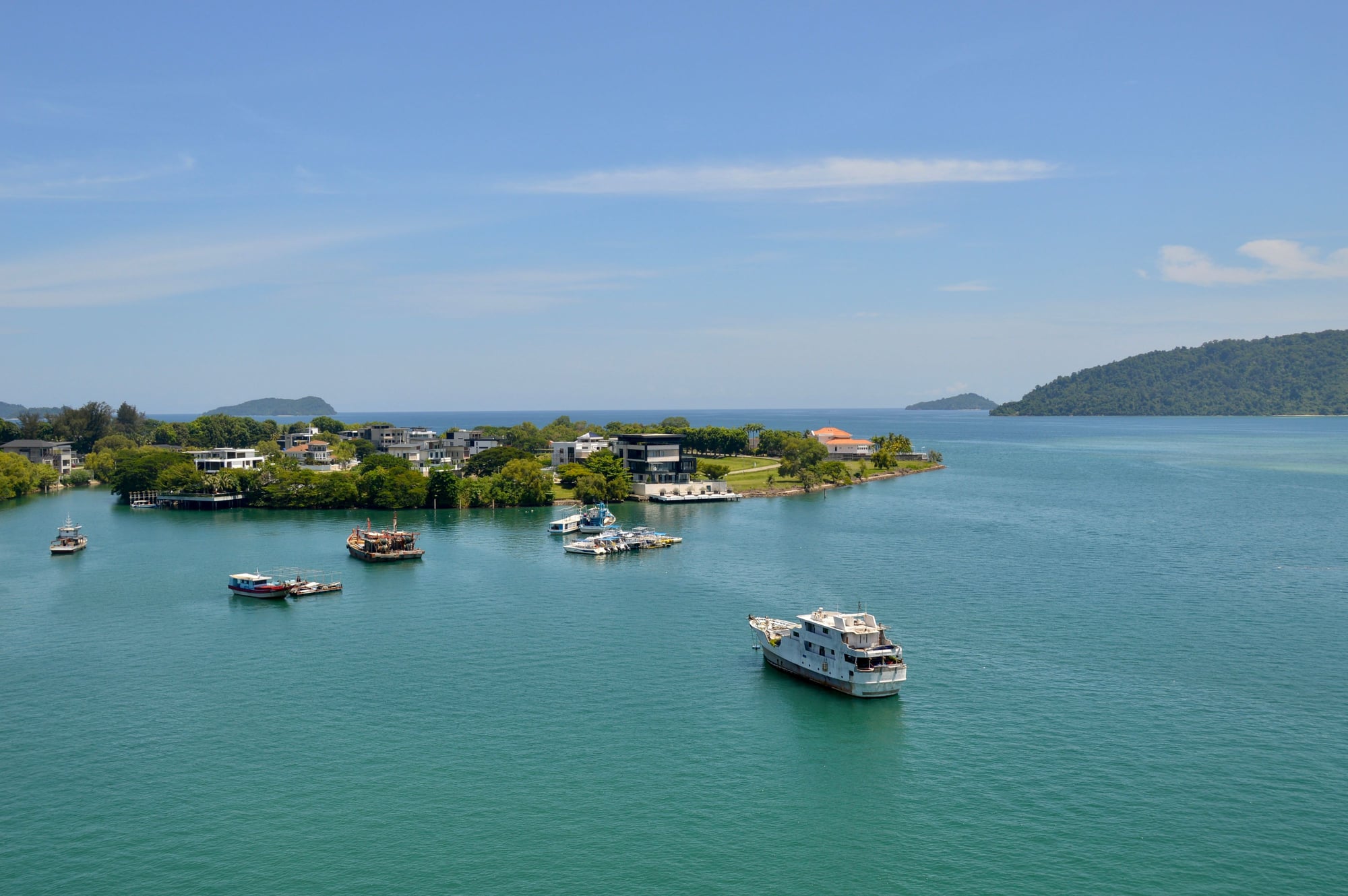
Every time I fly into Kota Kinabalu, Sabah’s capital, my first stop is Jalan Segama, otherwise known as Durian Street. Here, during the fruit season, vendors from various areas of Sabah and as far afield as Sarawak, Sabah’s southerly neighbor state, set up stands with generators and fluorescent lights to hawk the infamous and pungent fruit. Signs in hotels warn against bringing durian inside because the fruit has been described as smelling like gym socks, rotting flesh or raw sewage. I find that it smells like almond and onion. The odor is the most known characteristic of durian but there are plenty of other oddities related to the fruit. For instance, it’s given to patients in hospitals in the Philippines who have low blood pressure due to dengue fever because of the fruit’s capability to raise blood pressure. Perhaps relatedly, in Southeast Asia, you hear stories of people’s relatives who have dropped dead due to mixing durian with alcohol, which some believe to be a deadly concoction. It’s also the only plant-based food consumed regularly by tigers.
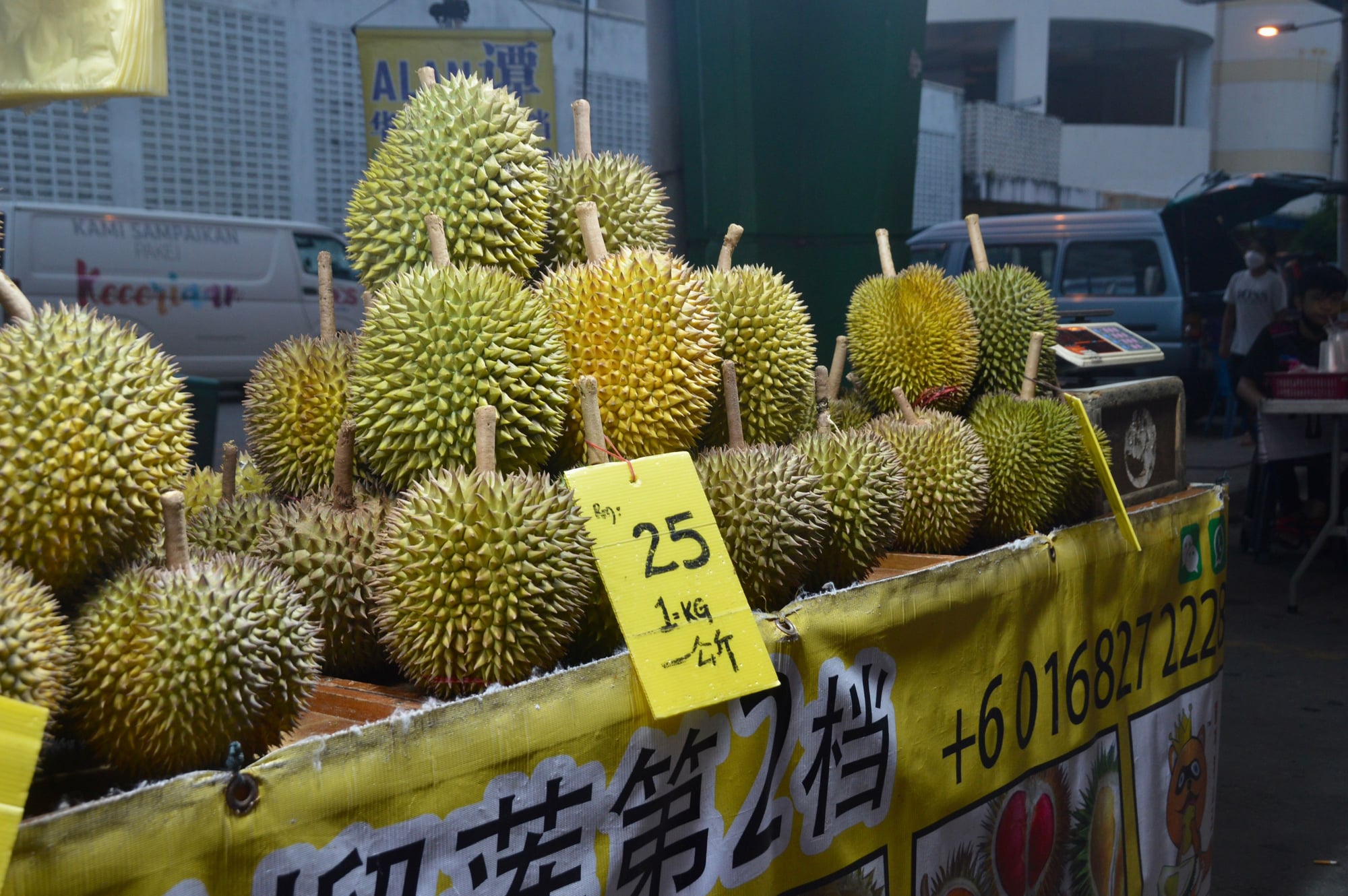
Durian shaped streetlights, durian murals on downtown buildings and freeze dried durian in every corner store remind you that if you are a durian lover, you are in the right place. Borneo is also one of the few places in the world where you can find wild jungle durian, which come in lipstick pink, fire truck red and almost neon orange. I won’t get too much into the botanical nerdom and Latin names here (if you’re a durian fan, you probably already know about Lindsay Gasik who is the expert on the subject and you can find more than you ever could’ve guessed there was to learn about durian on her website, Year of the Durian), but suffice it to say that I often crave the subtle, nutty flavor of these wild durians that are so thick and peanut buttery that they’re better sucked off the seed than bitten.
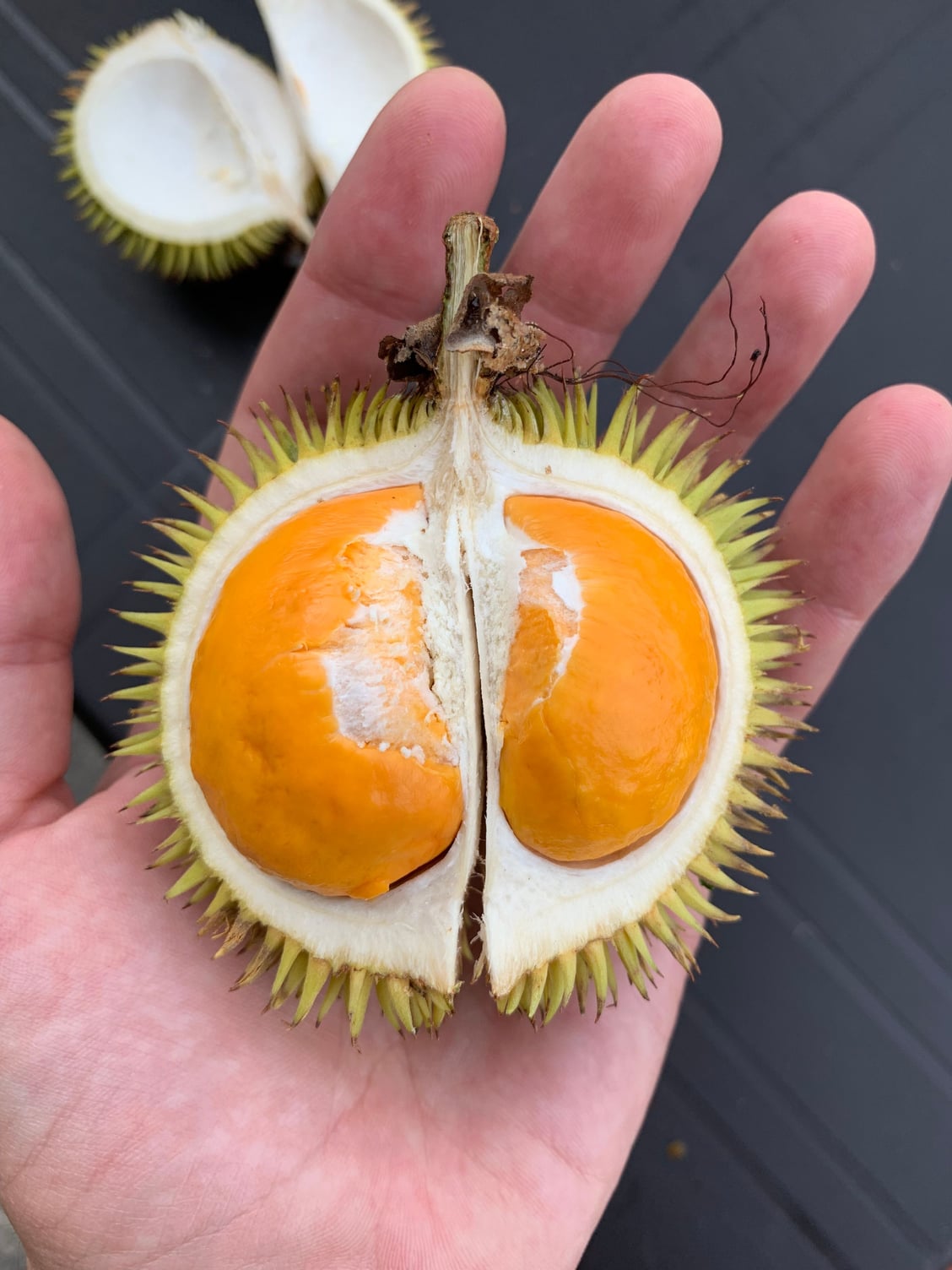

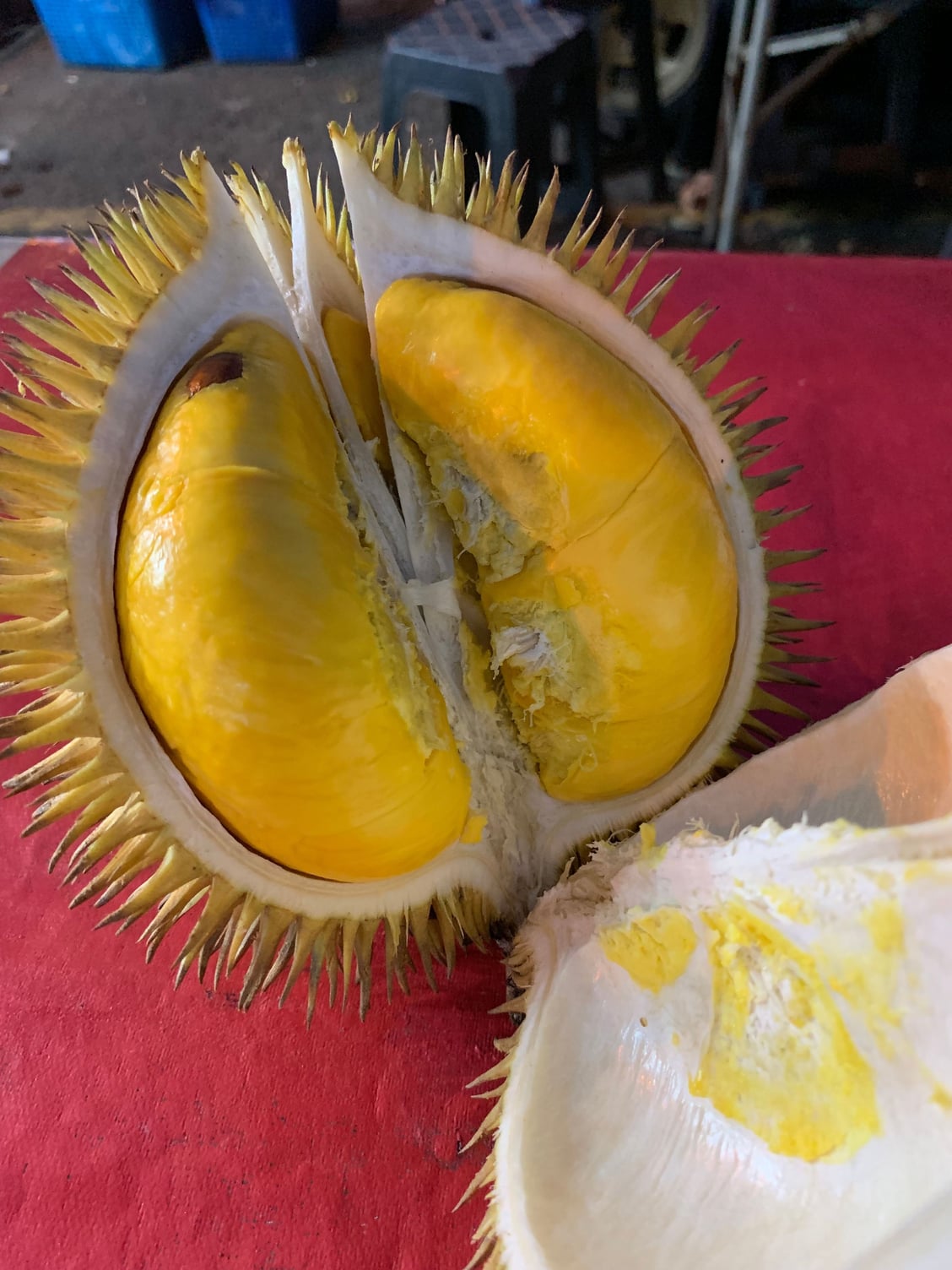
Other fruits you might find on Durian Street are tarap, which looks a bit like a Rick and Morty creation, pulasan, which glows like an ember, and cempedak, which has a scent that some say reminds them of honey and fermented urine.
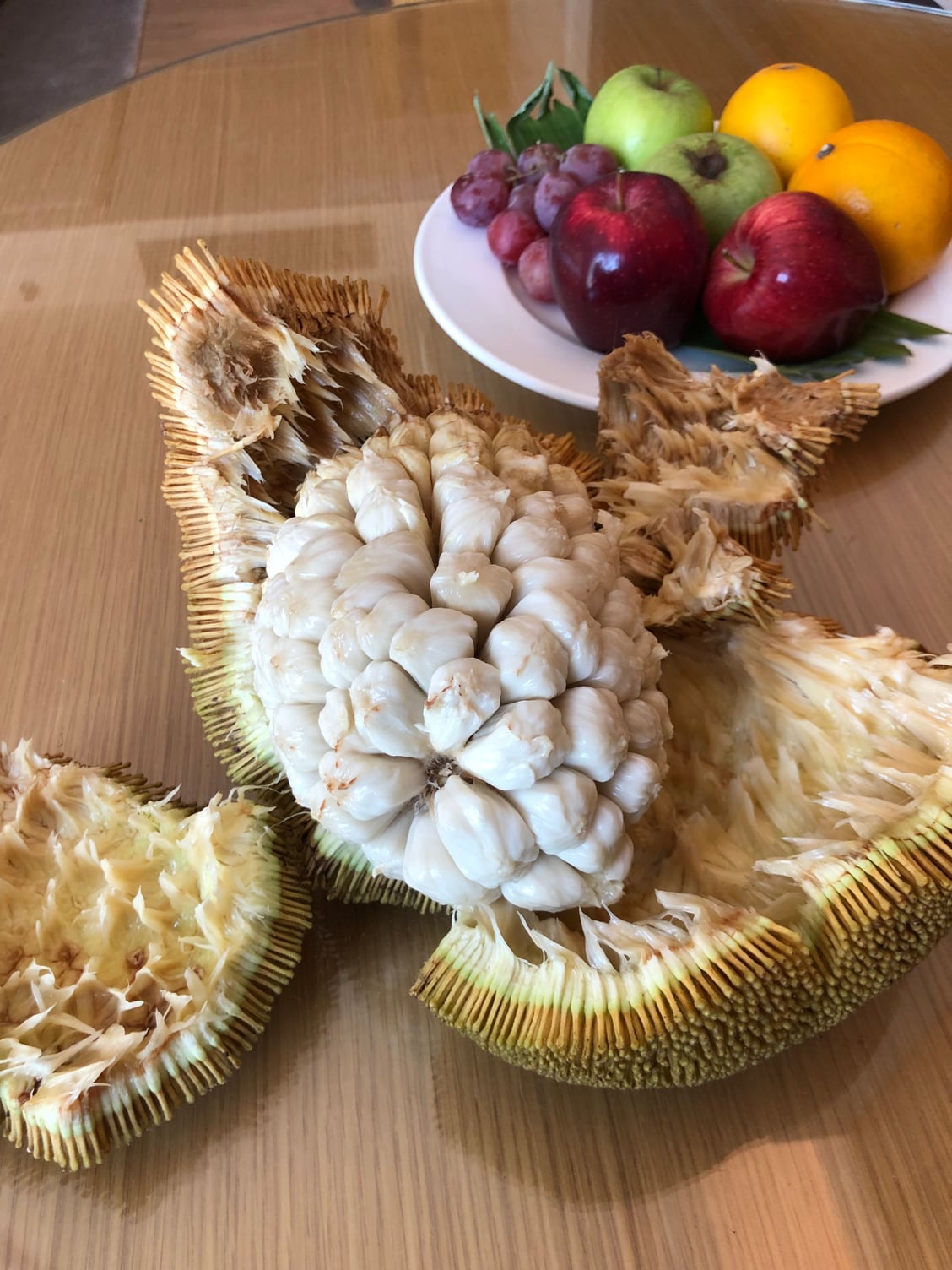

Under the fluorescent lights, tourists struggle against the humidity to get into single-use plastic gloves to keep their hands clean during the durian feast, which can be a messy affair. Durian shells litter the tables and seeds are picked out of the trash basket by the durian sellers’ kids. They fill entire trashbags full of them to bring home and plant. The trees will bear fruit in close to a decade and the’ll be trucked into Durian Street for a new crop of fruit lovers to enjoy.
In Kota Kinabalu’s high-end souvenir shops, behind glass cases, are box after box of exorbitantly priced edible birds nests, a beige, honeycomb-like bowl structure a bit larger than a half-dollar. Various species of swiftlets create the nests with their solidified saliva and the nests can fetch upwards of $3,000/pound. The nests are collected in caves at significant risk to the climbers’ lives but more and more, artificial nests are being built to house the birds. Malaysians will sometimes put up birdhouses in their back yard in the hope that swiftlets will find their property an appealing place to come live and spit out some nests. The nests are used to create soup, which can be served in either a sweet or savory variety. Although it’s phenomenally pricey, the soup is eaten in large quantities to better enjoy the texture. There is also a red varietal, known as a “blood nest.” At the same souvenir shops, you’ll find hedgehog bezoars, also prized in Chinese medicine, and also absurdly expensive. Down the street is the dried seafood market where a brisk trade in dried sea cucumbers is done. The things that tourists bring home do a good job of representing the uniqueness of Sabah’s.
But alright, enough of the city, the majority of the visitors who come to Sabah are here for the incredible wildlife, such as the endangered proboscis monkey. These primates have comically bulbous noses if they’re male or Pinocchio before telling a lie noses if they’re female. The males have potbellies and very prominent, very red penises which are often in view because of how the monkeys like to sit - legs spread wide apart with their hands on their knees. They subsist on unripe fruit and will die if they eat fruit that’s too ripe because it will ferment in the aforementioned belly, leading to fatal bloating. Their preferred way to enter the rivers along which they live to swim to the other side or to escape an airborne predator like one of Borneo’s many eagles is to bellyflop.

Sabah’s second claim to fame which smells like rotting flesh is the Rafflesia flower, a gigantic red petaled monstrosity also known as the corpse flower because of its stench. One of its species holds the title of largest flower in the world. The plant wouldn’t be out of place on the set of Little Shop of Horrors and visitors to Sabah trek through the jungle to observe and sniff the plant while it’s in bloom. It’s one thing for the flower to be featured on the back of a 10 ringgit note, but it is deeply weird that someone would think to name a medical center after the flower, given, you know, the whole rotting flesh thing. And on the topic of ringgit notes, Malaysia’s currency has also, at various points, featured the hornbill, a toucanesque bird with a bony helmet atop its bill, a betel nut chewing container, and a Boeing 777 belonging to the airline whose 777s have suffered two of the most spectacular catastrophes in recent memory.
So now, say you’re back from the jungle and ready for some dinner. Tourists flock to Kota Kinabalu for the shockingly cheap and fresh seafood. In the restaurants’ rows of tanks, massive painted rock lobsters sit with their antennae sticking out of the water, prawns swim against the current and crabs scuttle around on the backs of their unlucky cell mates. A dinner consisting of a crab, a massive plate of shrimp, sautťed water spinach, rice and a couple coconuts to drink (no booze - durian later!) will set you back less than 20 bucks. But the strangest of Sabah’s seafood offerings (which is saying something seeing as how the slipper lobster is ubiquitous) is the mantis shrimp, called thumb splitters by some, which has appendages that pack a nasty punch. As a result, each shrimp is packed into a plastic water bottle for safe handling.
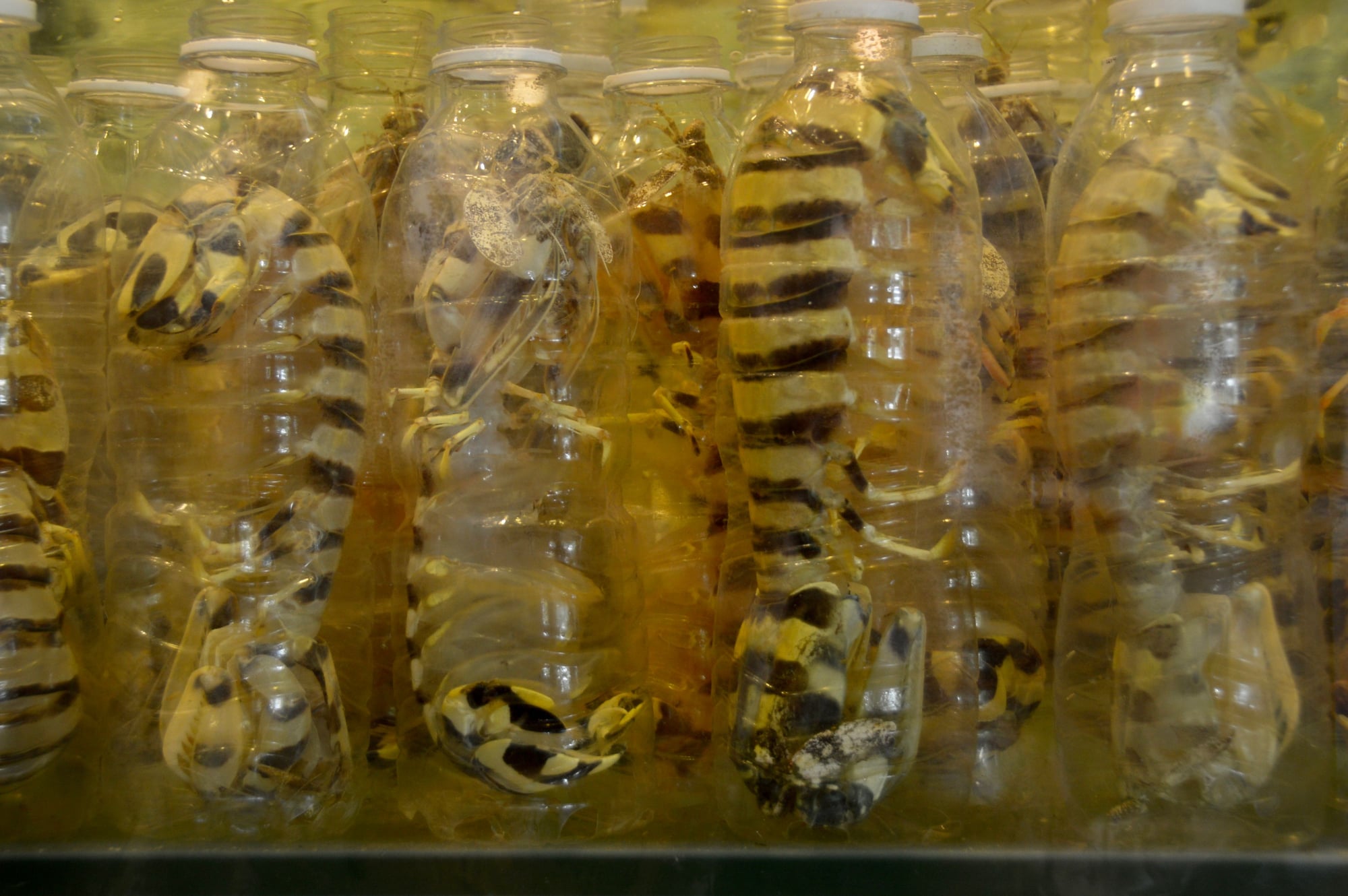
Kota Kinabalu is going to be big. As the gateway to the natural wonders of Sabah and with great snorkeling just a 15 minute speedboat ride away, new hotels and airline routes are betting on the region. A Hyatt Centric in downtown Kota Kinabalu is opening this year, and an Alila an hour north of the season is set to open soon as well. A Marriott and Holiday Inn have opened in the past few years. The city is huge with Korean tourists, and five airlines operate routes to Seoul, Busan and Muan. Before the pandemic, it was possible to fly direct to a half-dozen cities in China and plans are in the works to open routes to countries in the Middle East.
it’s still a little rough around the edges in some ways. The warm Thai style of dealing with tourism hasn’t arrived yet and maybe it never will. Service is a bit gruff. An ebullient “thank you” will almost always be met with an “OK.” The municipality would do well to deal with its rat problem and the legacy of tourist kidnappings by Filipino Islamist militants is probably still keeping some away. But if you came away from your last vacation feeling that it was a little tame, maybe it’s time for a trip to Sabah.
Will continue to post here but feel free to follow along at Six Months Home, Six Away, if you're interested in reading more and seeing more pictures. Would love to hear some travel blog insight as I've written travel journalism before but never published on my own platform!

Every time I fly into Kota Kinabalu, Sabah’s capital, my first stop is Jalan Segama, otherwise known as Durian Street. Here, during the fruit season, vendors from various areas of Sabah and as far afield as Sarawak, Sabah’s southerly neighbor state, set up stands with generators and fluorescent lights to hawk the infamous and pungent fruit. Signs in hotels warn against bringing durian inside because the fruit has been described as smelling like gym socks, rotting flesh or raw sewage. I find that it smells like almond and onion. The odor is the most known characteristic of durian but there are plenty of other oddities related to the fruit. For instance, it’s given to patients in hospitals in the Philippines who have low blood pressure due to dengue fever because of the fruit’s capability to raise blood pressure. Perhaps relatedly, in Southeast Asia, you hear stories of people’s relatives who have dropped dead due to mixing durian with alcohol, which some believe to be a deadly concoction. It’s also the only plant-based food consumed regularly by tigers.

Durian shaped streetlights, durian murals on downtown buildings and freeze dried durian in every corner store remind you that if you are a durian lover, you are in the right place. Borneo is also one of the few places in the world where you can find wild jungle durian, which come in lipstick pink, fire truck red and almost neon orange. I won’t get too much into the botanical nerdom and Latin names here (if you’re a durian fan, you probably already know about Lindsay Gasik who is the expert on the subject and you can find more than you ever could’ve guessed there was to learn about durian on her website, Year of the Durian), but suffice it to say that I often crave the subtle, nutty flavor of these wild durians that are so thick and peanut buttery that they’re better sucked off the seed than bitten.



Other fruits you might find on Durian Street are tarap, which looks a bit like a Rick and Morty creation, pulasan, which glows like an ember, and cempedak, which has a scent that some say reminds them of honey and fermented urine.


Under the fluorescent lights, tourists struggle against the humidity to get into single-use plastic gloves to keep their hands clean during the durian feast, which can be a messy affair. Durian shells litter the tables and seeds are picked out of the trash basket by the durian sellers’ kids. They fill entire trashbags full of them to bring home and plant. The trees will bear fruit in close to a decade and the’ll be trucked into Durian Street for a new crop of fruit lovers to enjoy.
In Kota Kinabalu’s high-end souvenir shops, behind glass cases, are box after box of exorbitantly priced edible birds nests, a beige, honeycomb-like bowl structure a bit larger than a half-dollar. Various species of swiftlets create the nests with their solidified saliva and the nests can fetch upwards of $3,000/pound. The nests are collected in caves at significant risk to the climbers’ lives but more and more, artificial nests are being built to house the birds. Malaysians will sometimes put up birdhouses in their back yard in the hope that swiftlets will find their property an appealing place to come live and spit out some nests. The nests are used to create soup, which can be served in either a sweet or savory variety. Although it’s phenomenally pricey, the soup is eaten in large quantities to better enjoy the texture. There is also a red varietal, known as a “blood nest.” At the same souvenir shops, you’ll find hedgehog bezoars, also prized in Chinese medicine, and also absurdly expensive. Down the street is the dried seafood market where a brisk trade in dried sea cucumbers is done. The things that tourists bring home do a good job of representing the uniqueness of Sabah’s.
But alright, enough of the city, the majority of the visitors who come to Sabah are here for the incredible wildlife, such as the endangered proboscis monkey. These primates have comically bulbous noses if they’re male or Pinocchio before telling a lie noses if they’re female. The males have potbellies and very prominent, very red penises which are often in view because of how the monkeys like to sit - legs spread wide apart with their hands on their knees. They subsist on unripe fruit and will die if they eat fruit that’s too ripe because it will ferment in the aforementioned belly, leading to fatal bloating. Their preferred way to enter the rivers along which they live to swim to the other side or to escape an airborne predator like one of Borneo’s many eagles is to bellyflop.

Sabah’s second claim to fame which smells like rotting flesh is the Rafflesia flower, a gigantic red petaled monstrosity also known as the corpse flower because of its stench. One of its species holds the title of largest flower in the world. The plant wouldn’t be out of place on the set of Little Shop of Horrors and visitors to Sabah trek through the jungle to observe and sniff the plant while it’s in bloom. It’s one thing for the flower to be featured on the back of a 10 ringgit note, but it is deeply weird that someone would think to name a medical center after the flower, given, you know, the whole rotting flesh thing. And on the topic of ringgit notes, Malaysia’s currency has also, at various points, featured the hornbill, a toucanesque bird with a bony helmet atop its bill, a betel nut chewing container, and a Boeing 777 belonging to the airline whose 777s have suffered two of the most spectacular catastrophes in recent memory.
So now, say you’re back from the jungle and ready for some dinner. Tourists flock to Kota Kinabalu for the shockingly cheap and fresh seafood. In the restaurants’ rows of tanks, massive painted rock lobsters sit with their antennae sticking out of the water, prawns swim against the current and crabs scuttle around on the backs of their unlucky cell mates. A dinner consisting of a crab, a massive plate of shrimp, sautťed water spinach, rice and a couple coconuts to drink (no booze - durian later!) will set you back less than 20 bucks. But the strangest of Sabah’s seafood offerings (which is saying something seeing as how the slipper lobster is ubiquitous) is the mantis shrimp, called thumb splitters by some, which has appendages that pack a nasty punch. As a result, each shrimp is packed into a plastic water bottle for safe handling.

Kota Kinabalu is going to be big. As the gateway to the natural wonders of Sabah and with great snorkeling just a 15 minute speedboat ride away, new hotels and airline routes are betting on the region. A Hyatt Centric in downtown Kota Kinabalu is opening this year, and an Alila an hour north of the season is set to open soon as well. A Marriott and Holiday Inn have opened in the past few years. The city is huge with Korean tourists, and five airlines operate routes to Seoul, Busan and Muan. Before the pandemic, it was possible to fly direct to a half-dozen cities in China and plans are in the works to open routes to countries in the Middle East.
it’s still a little rough around the edges in some ways. The warm Thai style of dealing with tourism hasn’t arrived yet and maybe it never will. Service is a bit gruff. An ebullient “thank you” will almost always be met with an “OK.” The municipality would do well to deal with its rat problem and the legacy of tourist kidnappings by Filipino Islamist militants is probably still keeping some away. But if you came away from your last vacation feeling that it was a little tame, maybe it’s time for a trip to Sabah.
Will continue to post here but feel free to follow along at Six Months Home, Six Away, if you're interested in reading more and seeing more pictures. Would love to hear some travel blog insight as I've written travel journalism before but never published on my own platform!
#2
Join Date: May 2005
Location: London, England, United Kingdom
Programs: Marriott (Lifetime Titantium), whatever other programs as benefits make sense.
Posts: 1,921
Interesting to read about Kota Kinabalu. I have only had durian in Zanzibar, and thanks to your link to Lindsay's site, now realise that there are many versions of durian!
Looking forward to the rest.
Looking forward to the rest.
#3
Community Director Emerita
Join Date: Oct 2000
Location: Anywhere warm
Posts: 33,756
Fascinating discussion of fruit. I'm looking forward to learning more about this part of the world. I've been to Borneo and seen orangutans, and look forward to broadening my knowledge.
#5
Original Poster
Join Date: Jun 2011
Location: New York
Programs: Delta SM
Posts: 153
The Kinabatangan River Floodplain, on the eastern side of Malaysian Borneo, is often billed as having the highest concentration of wildlife in Southeast Asia. This quickly becomes apparent when you cruise down the river and see a Bornean Pygmy elephant, a pair of pied hornbills and a long tailed macaque all sharing a tree - the hornbill perched high in the branches, the macaque harvesting fruit a few feet below, and the elephant grasping the trunk with its tusk as it pulls itself out of the water and onto the riverbank. Later, an endangered (both in terms of conservation and the crocodile-infested river) proboscis monkey and a baby crocodile were mere feet from each other vertically as a serpent eagle flew above. I first came to the Kinabatangan River three years ago and struck out trying to see the Borneo Big Five - orangutan, pygmy elephant, rhinoceros hornbill, crocodile and Proboscis monkey. This time I was luckier.
To get to the Kinabatangan, you have to fly into Sandakan, infamous for World War Twoís infamous death march of Allied prisoners held by Japan, and then either drive for three hours or take a boat along the coast and then up the mouth of the river. Though the situation has improved in recent years, the east coast of Sabah has been a hotspot for kidnappings by Abu Sayyaf, the ISIS affiliate in the Philippines. Tourists, often on boats or resort islands, have been targeted on a number of occasions, held for ransom and in some cases beheaded. The threat of piracy was enough to make me choose the overland option though it was bumpy and the only scenery was acres of palm oil plantations.
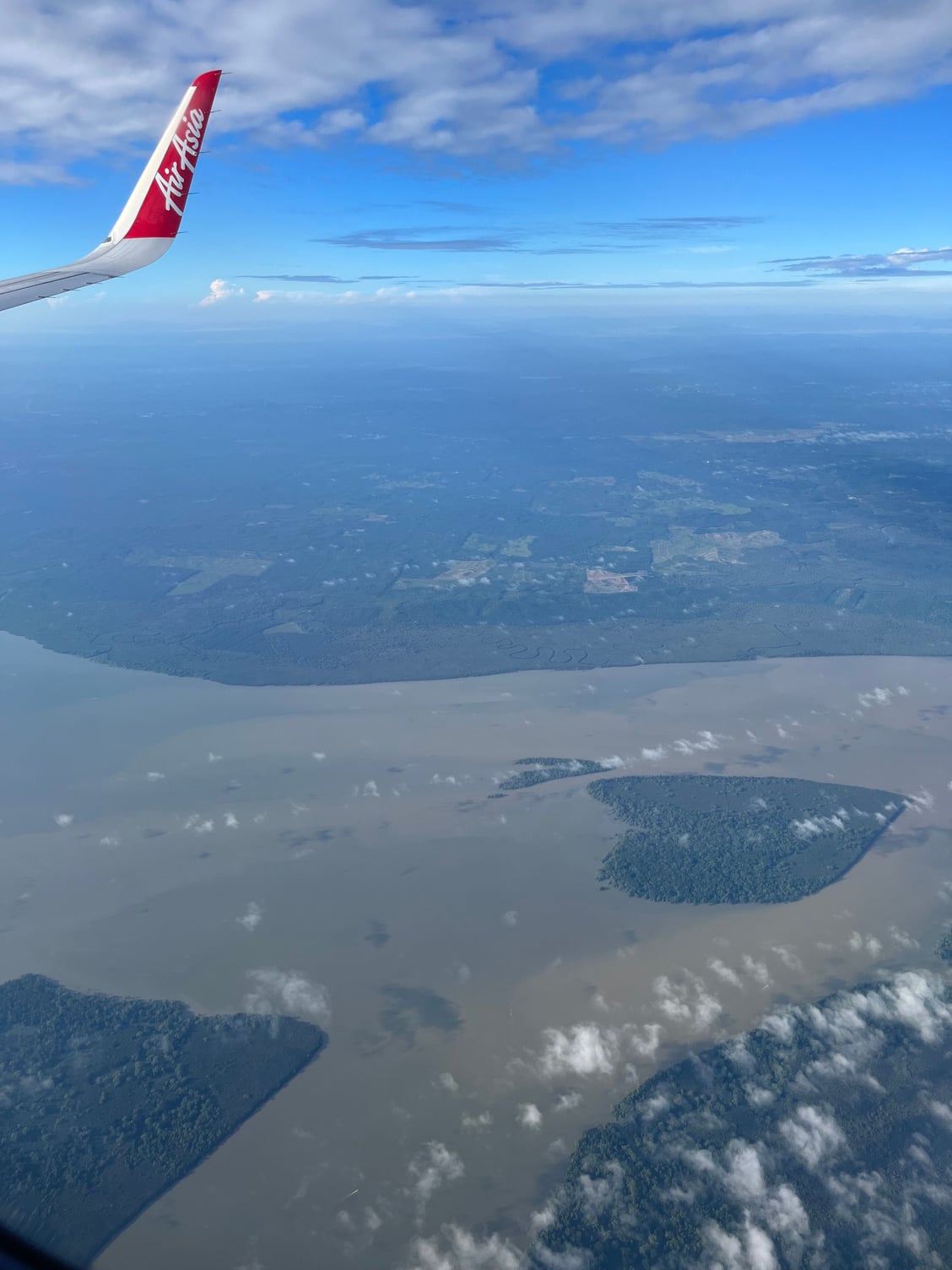
The Kinabatangan River
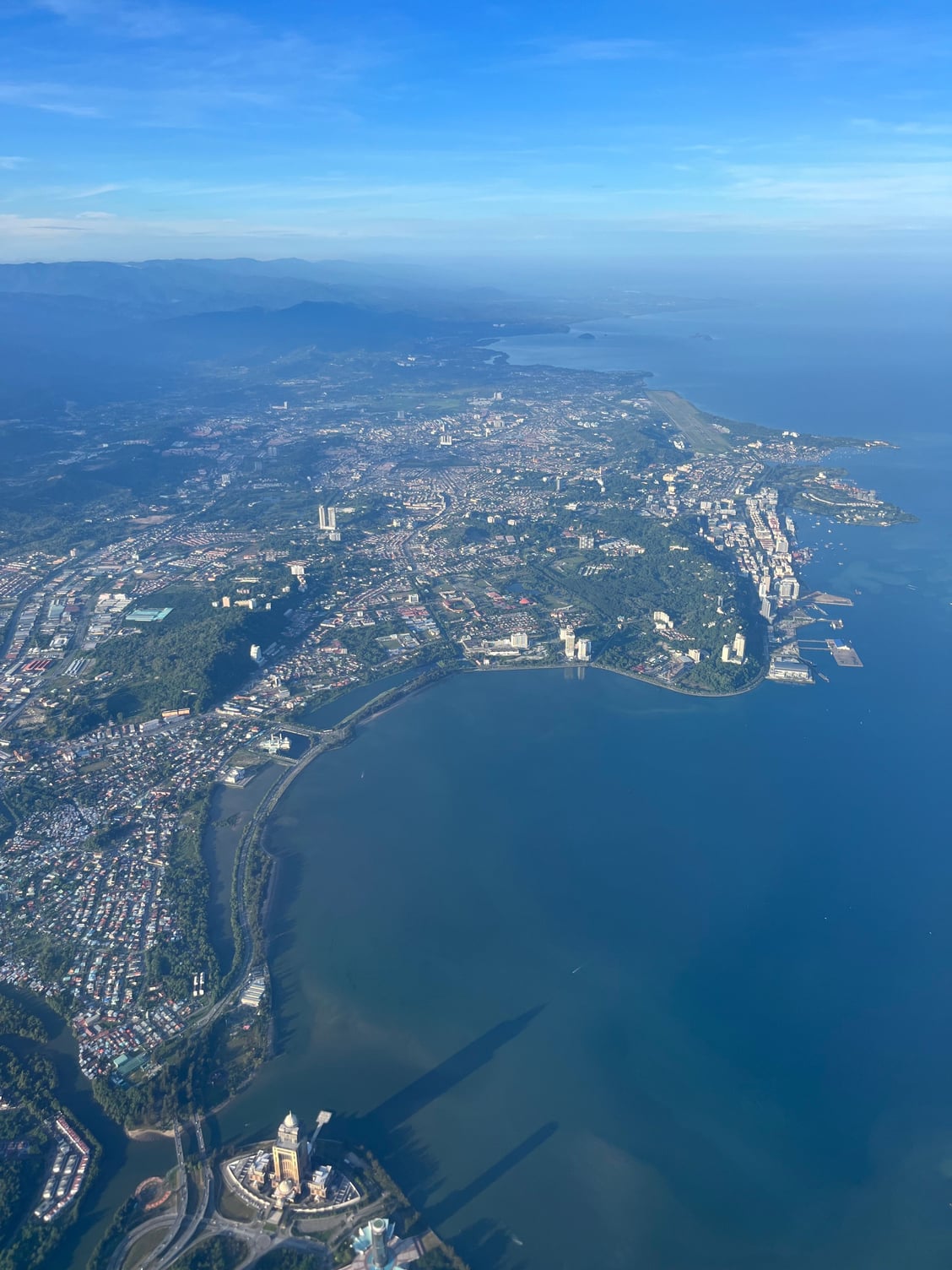
Sandakan from above
Most tours of the Kinabatangan (doing it by yourself is a non-starter) include a stop at the Sepilok Orangutan Rehabilitation Center. The center takes in orphaned or injured apes and teaches them the skills theyíll need in the wild so they can be reintroduced into the jungle. Sightings of the great apes arenít guaranteed, as the rehabilitation center, which borders the rain forest, isnít enclosed, though given the fact that massive baskets of fruit and vegetables are dumped on viewing platforms, it seems that chances are fairly good though we did talk to some tourists later that weekend who had been skunked. I guess if youíre an orangutan, there is such a thing as a free lunch. It seems we did get lucky by seeing a fully flanged adult male, almost as old as I am.

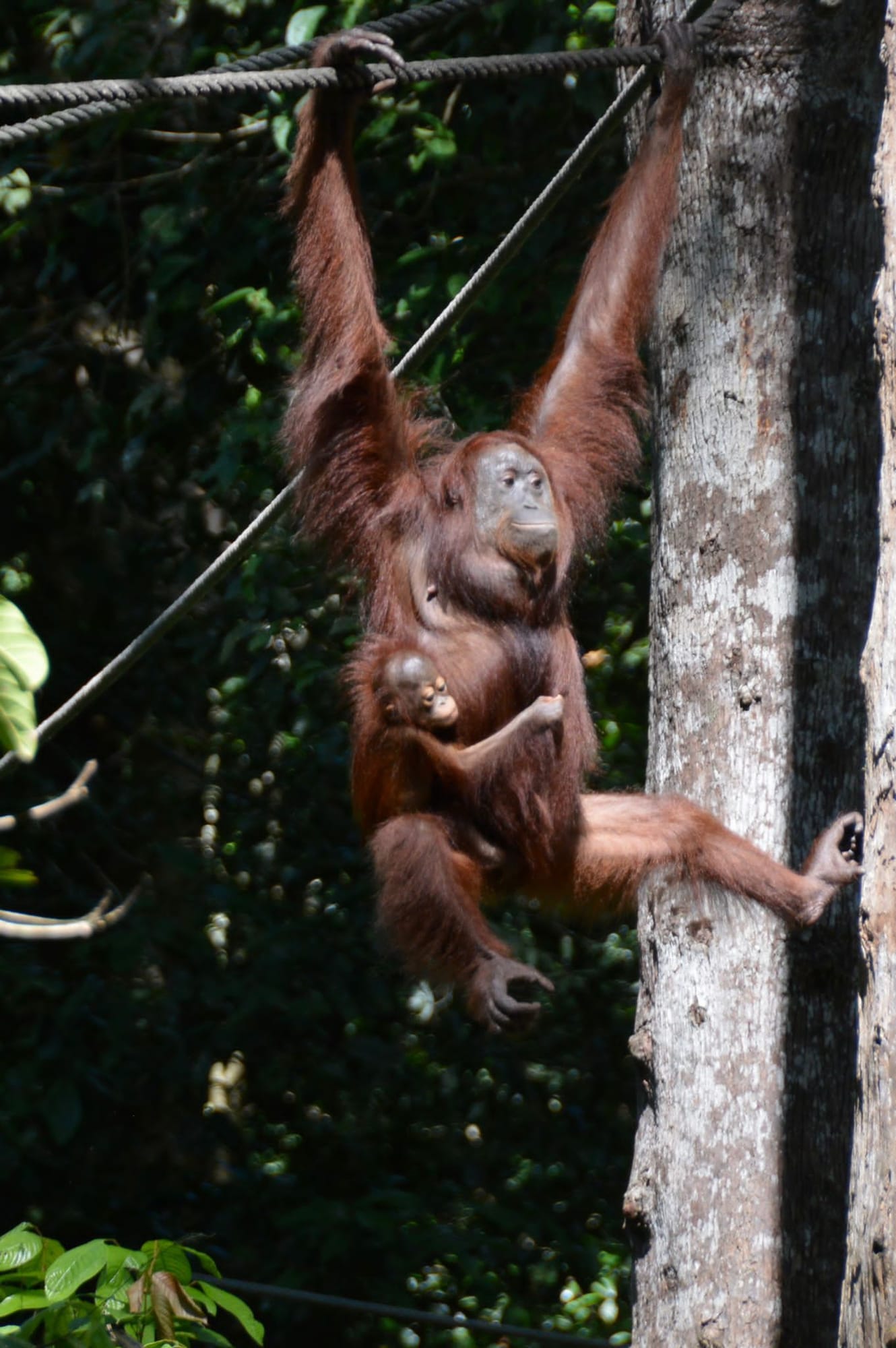
After lunch, it was back on the bumpy road towards our lodge on the Kinabatangan. Iíve now stayed at two Kinabatangan lodges and they seem to be more or less the same. The rooms are simple and reek of mildew but thatís the price you pay for being situated in the middle of a rain forest. The dining room is outdoors and perched on the river where you get great sunsets with bats and swallows swooping overhead and more geckos running around than you can count. Meals are served buffet style and you donít go to the Kinabatangan for the food.
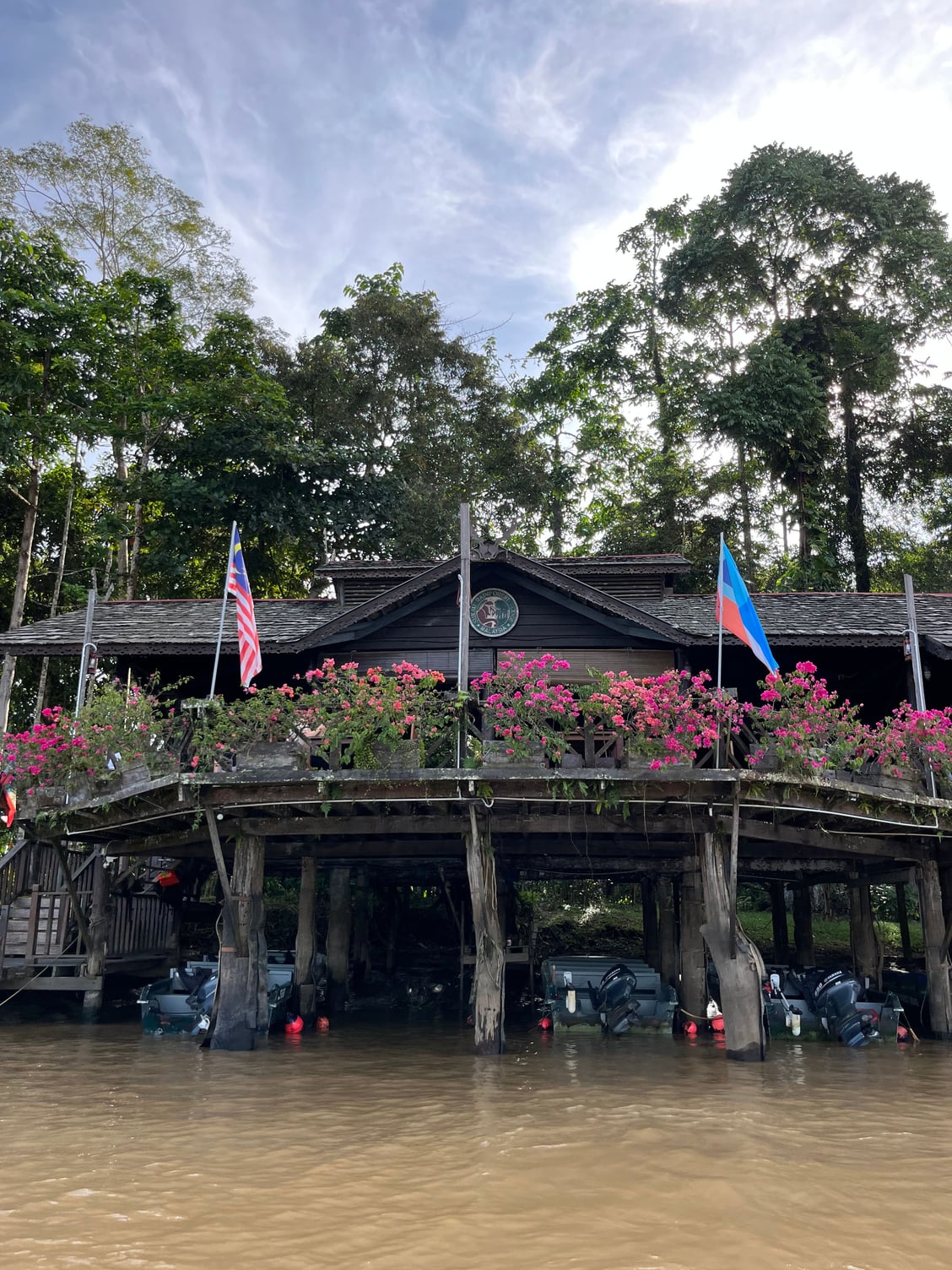
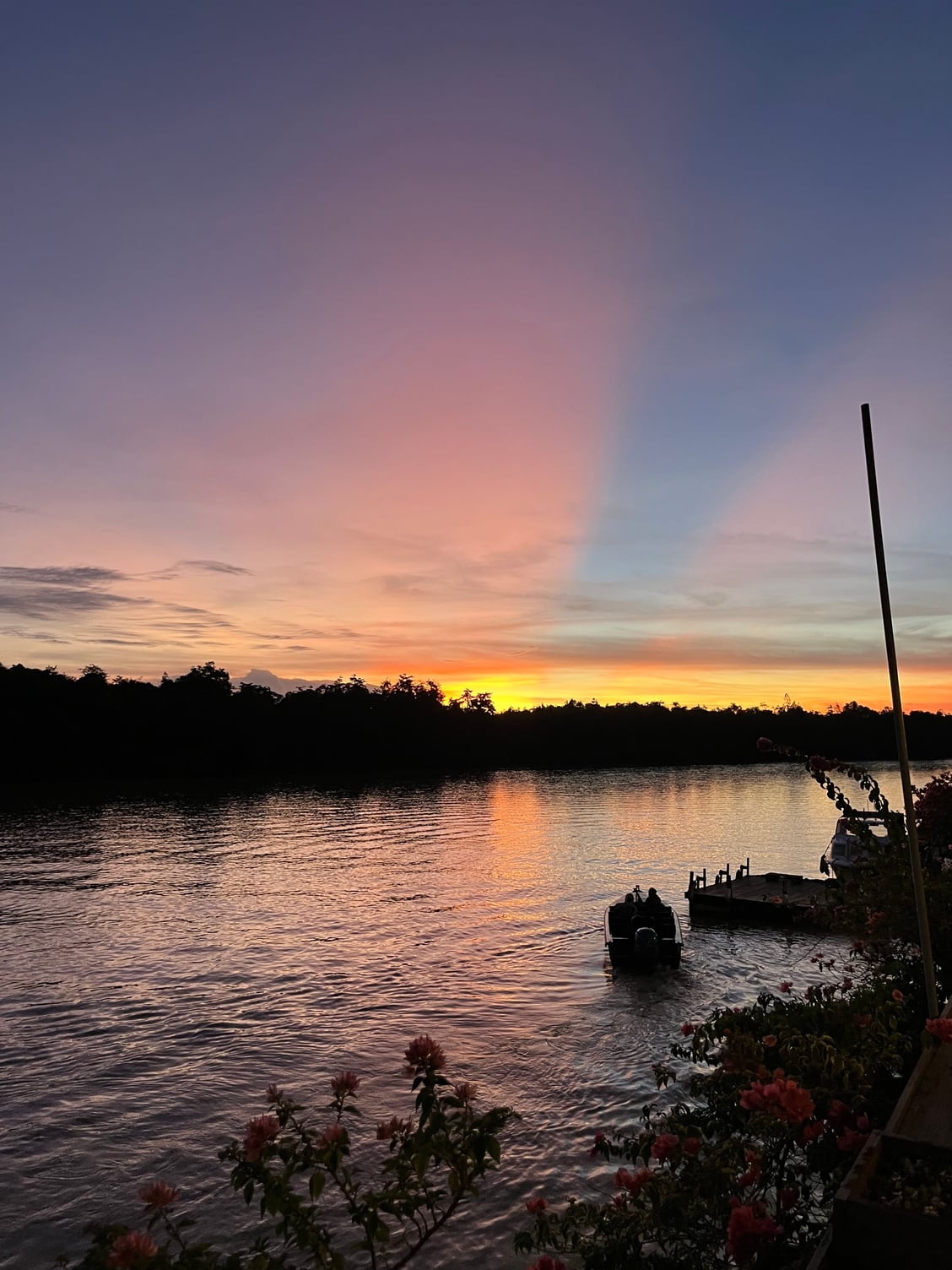
Typically, there are a couple of river cruises a day, at sunrise and in the evening, and some downtime in between. Ten or twelve people don a life jacket and pile into the boat with a driver and a guide. As with African safaris, there are other groups on the river and a cluster of boats under a tree is a good sign that something has been spotted. Many cruises begin with a hornbill sighting, of which there are seven species on the river. They fly in an exaggerated peak to trough motion. These birds are the toucans of Borneo, with their massive colorful (or black and white ) beaks and helmets rendering them unmistakable. Proboscis monkeys are a certainty, as are a host of other monkey types. Crocodiles are spotted along the muddy banks of the river with eagle eyes by the guides - they blend in quite well with driftwood. Itís rarer to catch a glimpse of an orangutan, sun bear or jaguar, the last of which are nocturnal.
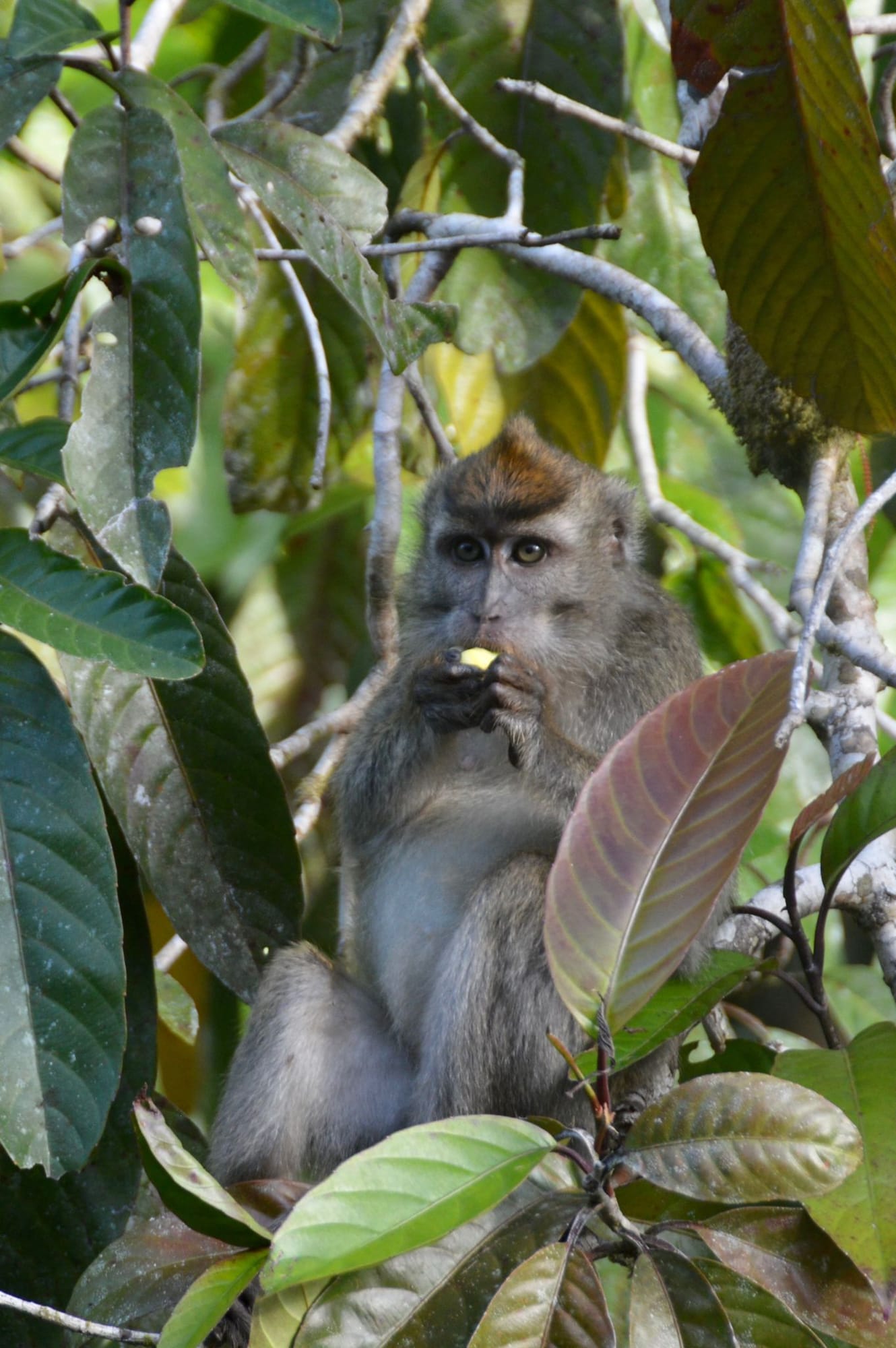
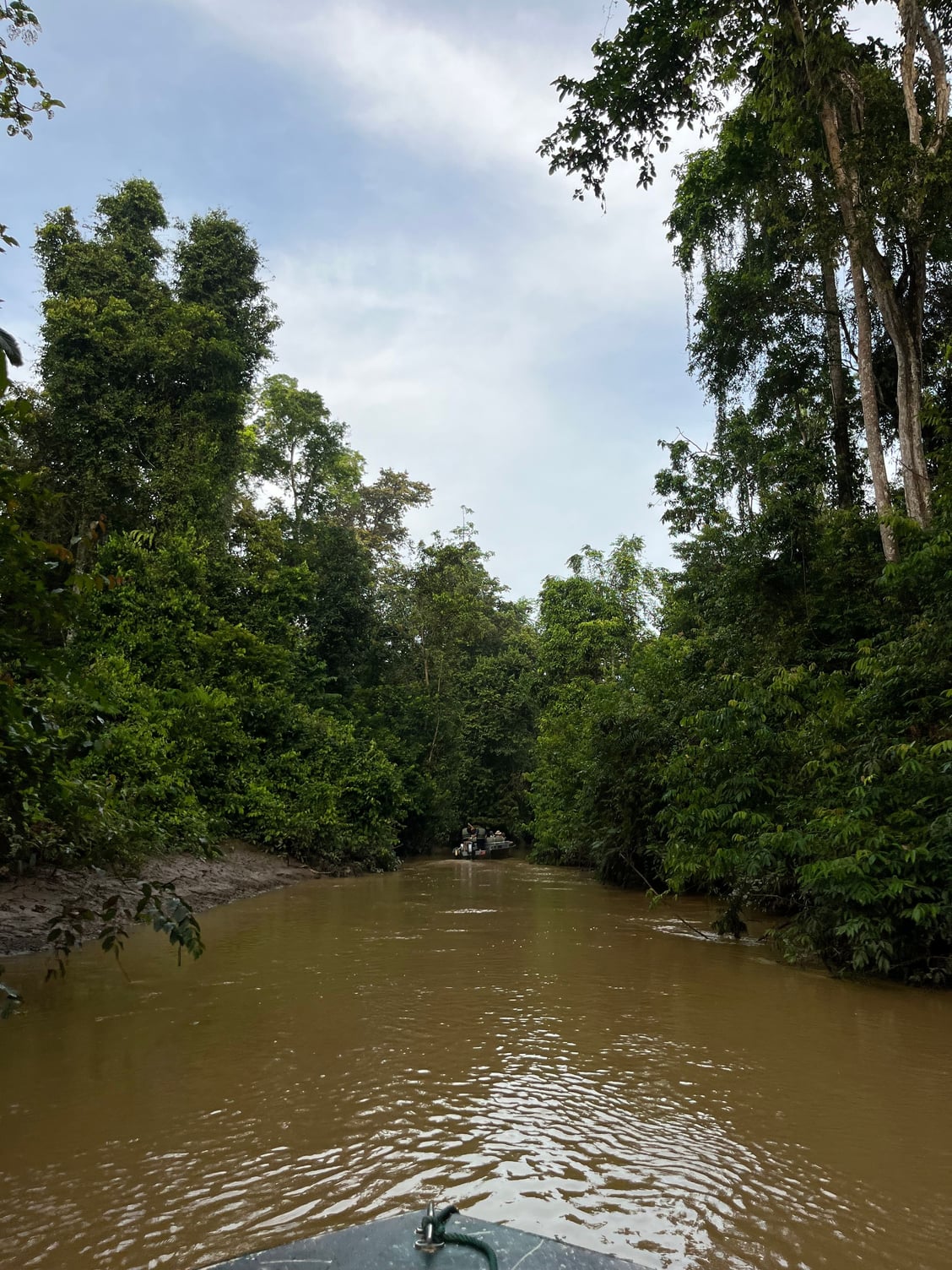
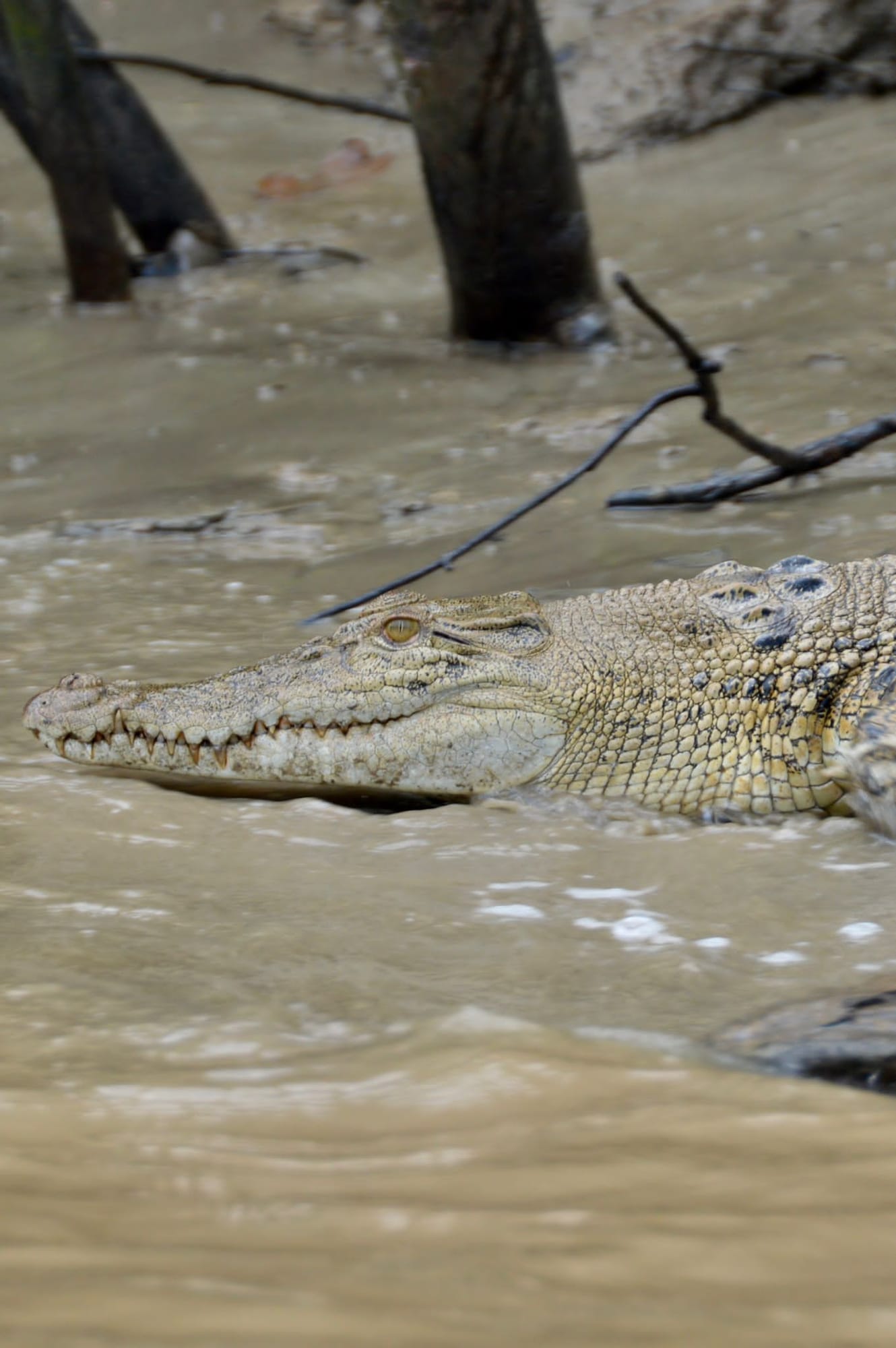
But I had come back to the Kinabatangan to complete the Big Five, which meant that I would need to check off pygmy elephant and orangutan. The two elephant herds that live on the river are migratory and travel along the river in search of food. When we were there, they had already migrated towards the mouth of the river so we didnít see them on the cruises that were included in our stay. However, the lodge offered a mid-day elephant cruise which didnít guarantee a sighting, was a couple hundred bucks and involved three hours each way on an uncomfortable wood bench in an uncovered speedboat to where the elephants had last been sighted. Oh, and it was supposed to rain as well. But it was our best shot at catching a glimpse of the elephants and two very enthusiastic, older Australian tourists who had gone the day before with camera gear that could be sold to put a down payment on a house talked us into it.
So, with four Swiss tourists and a guide, we clambered into the boat, wearing the Australiansí rain gear because we hadnít thought to bring any. Once youíve done a few days on the river, you no longer want to stop for proboscis monkeys or macaques and our guide sensed this, so we bombed down the river in search of elephants. The weather report was correct and a half-hour in, we were getting soaked. Blue sky was always on the horizon though, and after a shower that was unpleasant but not nearly as bad as it could have been, we were peeling off ponchos and drying off in the wind. As we got closer to where heíd seen the elephants, our guide, Jamal, steered the boat from one side of the river to the other, looking for where the elephants had crushed the vegetation to clear a path to the river. My bladder couldnít take it much longer and I asked Jamal If we could pull over so I could pee on a tree but he told me to wait just a bit - he was in elephant finding mode. And find them, he didÖ Stay tuned!

To get to the Kinabatangan, you have to fly into Sandakan, infamous for World War Twoís infamous death march of Allied prisoners held by Japan, and then either drive for three hours or take a boat along the coast and then up the mouth of the river. Though the situation has improved in recent years, the east coast of Sabah has been a hotspot for kidnappings by Abu Sayyaf, the ISIS affiliate in the Philippines. Tourists, often on boats or resort islands, have been targeted on a number of occasions, held for ransom and in some cases beheaded. The threat of piracy was enough to make me choose the overland option though it was bumpy and the only scenery was acres of palm oil plantations.

The Kinabatangan River

Sandakan from above
Most tours of the Kinabatangan (doing it by yourself is a non-starter) include a stop at the Sepilok Orangutan Rehabilitation Center. The center takes in orphaned or injured apes and teaches them the skills theyíll need in the wild so they can be reintroduced into the jungle. Sightings of the great apes arenít guaranteed, as the rehabilitation center, which borders the rain forest, isnít enclosed, though given the fact that massive baskets of fruit and vegetables are dumped on viewing platforms, it seems that chances are fairly good though we did talk to some tourists later that weekend who had been skunked. I guess if youíre an orangutan, there is such a thing as a free lunch. It seems we did get lucky by seeing a fully flanged adult male, almost as old as I am.


After lunch, it was back on the bumpy road towards our lodge on the Kinabatangan. Iíve now stayed at two Kinabatangan lodges and they seem to be more or less the same. The rooms are simple and reek of mildew but thatís the price you pay for being situated in the middle of a rain forest. The dining room is outdoors and perched on the river where you get great sunsets with bats and swallows swooping overhead and more geckos running around than you can count. Meals are served buffet style and you donít go to the Kinabatangan for the food.


Typically, there are a couple of river cruises a day, at sunrise and in the evening, and some downtime in between. Ten or twelve people don a life jacket and pile into the boat with a driver and a guide. As with African safaris, there are other groups on the river and a cluster of boats under a tree is a good sign that something has been spotted. Many cruises begin with a hornbill sighting, of which there are seven species on the river. They fly in an exaggerated peak to trough motion. These birds are the toucans of Borneo, with their massive colorful (or black and white ) beaks and helmets rendering them unmistakable. Proboscis monkeys are a certainty, as are a host of other monkey types. Crocodiles are spotted along the muddy banks of the river with eagle eyes by the guides - they blend in quite well with driftwood. Itís rarer to catch a glimpse of an orangutan, sun bear or jaguar, the last of which are nocturnal.



But I had come back to the Kinabatangan to complete the Big Five, which meant that I would need to check off pygmy elephant and orangutan. The two elephant herds that live on the river are migratory and travel along the river in search of food. When we were there, they had already migrated towards the mouth of the river so we didnít see them on the cruises that were included in our stay. However, the lodge offered a mid-day elephant cruise which didnít guarantee a sighting, was a couple hundred bucks and involved three hours each way on an uncomfortable wood bench in an uncovered speedboat to where the elephants had last been sighted. Oh, and it was supposed to rain as well. But it was our best shot at catching a glimpse of the elephants and two very enthusiastic, older Australian tourists who had gone the day before with camera gear that could be sold to put a down payment on a house talked us into it.
So, with four Swiss tourists and a guide, we clambered into the boat, wearing the Australiansí rain gear because we hadnít thought to bring any. Once youíve done a few days on the river, you no longer want to stop for proboscis monkeys or macaques and our guide sensed this, so we bombed down the river in search of elephants. The weather report was correct and a half-hour in, we were getting soaked. Blue sky was always on the horizon though, and after a shower that was unpleasant but not nearly as bad as it could have been, we were peeling off ponchos and drying off in the wind. As we got closer to where heíd seen the elephants, our guide, Jamal, steered the boat from one side of the river to the other, looking for where the elephants had crushed the vegetation to clear a path to the river. My bladder couldnít take it much longer and I asked Jamal If we could pull over so I could pee on a tree but he told me to wait just a bit - he was in elephant finding mode. And find them, he didÖ Stay tuned!

#7
Original Poster
Join Date: Jun 2011
Location: New York
Programs: Delta SM
Posts: 153
Thank you! It's changed vastly even from when I first went in 2018. They're building everywhere in Kota Kinabalu and I would be surprised if it weren't a tourist hotspot in the next decade for western visitors (it already is with Chinese, Korean and Japanese tourists, as well as peninsular Malaysians).
#8
Join Date: Aug 2018
Posts: 67
ruby&carlos did you make it to lahad datu or borneo rainforest lodge? i'm curious if there's anything beyond the Kinabatanan river cruise or if it's more or less the same (Big 5)
#10
Join Date: Nov 2019
Location: Newcastle, UK
Programs: BAEC Gold, IHG Platinum, FlyingBlue Gold, Hilton Gold, Mucci des repas d'enfant
Posts: 2,539
Very glad this has found its way to the top of the list. Like GregWTravels I’ve only had Durian in Zanzibar so that was educational. A great read.




















